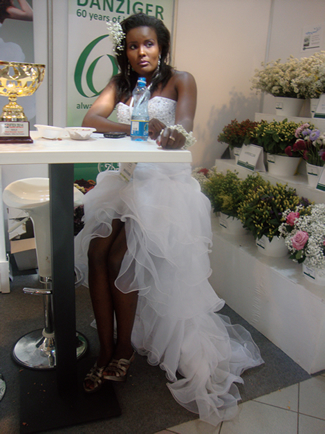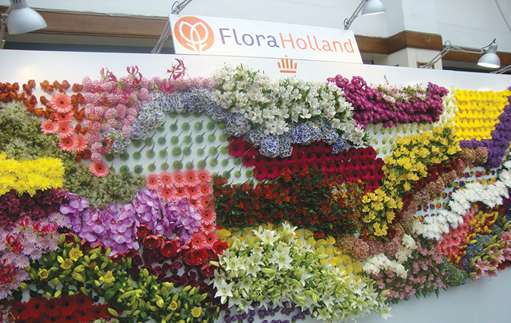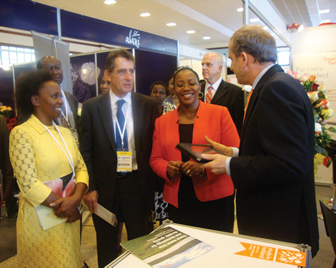 As the curtain of the 4th edition of the International Floriculture Trade Expo (IFTEX) 2015 opens from 3rd to 5th June, there will be no room for any shortcoming that may hamper its success. All minds and hands that know what it entails have been up and down trying to put different pieces together to make what can be seen as the true spirit of the regional horticultural industry.
As the curtain of the 4th edition of the International Floriculture Trade Expo (IFTEX) 2015 opens from 3rd to 5th June, there will be no room for any shortcoming that may hamper its success. All minds and hands that know what it entails have been up and down trying to put different pieces together to make what can be seen as the true spirit of the regional horticultural industry.
The event, since its inception in 2012 has continued to aggressively spread its tentacles world over, luring to its importance the most reputed and less comparable companies in various businesses of sorts.
The beginning of the event concept wasn’t such humble though the humidity and value that is endowed in the event itself reflects a totally different picture. Good institutional organization, positive projection and a solemn consideration of participants’ interests.
According to the organizers, the tussle process of liaising with potential exhibitors and buyers is becoming less hectic due to the consideration that people have absorbed the IFTEX concept and can no longer be enticed in order to participate in it. Instead they prepare in time and consider how best they can make the best out of the entire event. Most of the exhibitors have participated previously and know pretty well what is entailed in the process.
 Thanks to HPP Exhibitions who have tirelessly worked all round to have the horticultural fraternity exhibit their products and highlight their best practices. They have expanded their scope by adding more space to accommodate more exhibitors. Good enough the small scale growers will not be left behind since they will have a chance to market their products. This show grows bigger and better every year making record as the fastest growing event in the history of international flower trade fairs, attracting flower growers from even other continents to exhibit. As HPP spokesman Jasper van Dijk put it It is like a tornado, the show has a fresh face at every turn, there is no telling where it is heading but what is clear, is its phenomenal growth towards a world class trade exhibition. One mission of bringing the world to source flowers in the country where they are grown have been achieved indeed.
Thanks to HPP Exhibitions who have tirelessly worked all round to have the horticultural fraternity exhibit their products and highlight their best practices. They have expanded their scope by adding more space to accommodate more exhibitors. Good enough the small scale growers will not be left behind since they will have a chance to market their products. This show grows bigger and better every year making record as the fastest growing event in the history of international flower trade fairs, attracting flower growers from even other continents to exhibit. As HPP spokesman Jasper van Dijk put it It is like a tornado, the show has a fresh face at every turn, there is no telling where it is heading but what is clear, is its phenomenal growth towards a world class trade exhibition. One mission of bringing the world to source flowers in the country where they are grown have been achieved indeed.
But is it all that HPP Exhibitions’ vision encompasses? Not really. The organization’s President, Dick Van Raamsdonk takes this as a good of a prospective future for such events and firmly holds that IFTEX has grown and will stop at nothing to make sure it satisfy the exhibitors and the visitors.
Exploring the rapid growth of the horticultural industry reveals more than meets the eye. For example, in the next one year additional 200 ha of new roses are projected. This brings in an estimated 200 million dollars’ worth of investment within this vast area. If this is anything to go by then HPP Exhibitions is not yet done with its target.
The government, in this respect, has to swallow a bitter pill for its lassitude to expand with the new developments. The ministries of East Arican Community, Commerce and Tourism as well as foreign Affairs and International Trade haven’t looked beyond to tap this potential. Soon hordes and hordes of investors will be on a clear road to the regional destinations if they don’t act fast enough to develop infrastructures for international Exhibitions.
Fast growth
Notwithstanding a few hitches that have almost docked many investment sectors, the horticulture one of the fast lane included.
 Exports have been fairly well with a corresponding number of new investors in the sector: Of course a few shortcomings such as insecurity, poor infrastructure, devolution and inappropriate Information Technology (IT) policies among others have been a hindrance to the vibrancy of the sector. Where insecurity has been rife, economic performance has forcefully gone down and this affects every other sector in the country, horticulture included.
Exports have been fairly well with a corresponding number of new investors in the sector: Of course a few shortcomings such as insecurity, poor infrastructure, devolution and inappropriate Information Technology (IT) policies among others have been a hindrance to the vibrancy of the sector. Where insecurity has been rife, economic performance has forcefully gone down and this affects every other sector in the country, horticulture included.
At least 500,000 people derive their livelihood from the sector through employment. With this in consideration, everything possible has to be done to save the sector. The current challenge that niggles the minds of exporters to the European Union Market is the issue of renewed, stricter standards. The phytosanitary regulations set up may not be quite friendly to the exporters but fortunately, the inspection regimes set by Kenya Plant Health Inspectorate Service may save the day.
IFTEX show is highly rated because of its uniqueness. No other event in the region is better organized and quite a practical trade tool to pull together horticultural sector stakeholders. Unlike other events conceived like the fair, IFTEX is an archetypical business platform that attracts business minded personalities and groups. It does not serve any other purpose other than developing formidable business axons between growers and buyers. No wonder there has been constant increase rather than decline in the number of participants.
Over 5,000 visitors are expected to visit the stands this year. Key among them are buyers from EU, Russia, USA, Middle and Far East, and China. In addition a entourage of dignitaries who are expected to explore newer business frontiers on which they can anchor some investment will attend. Expected are representatives from Rwanda, Ethiopia, Zambia, Zimbabwe, Uganda, South Africa and Tanzania which are fast developing their agricultural sectors to accede to some international rating are expected. They may with time, compliment Kenya in flower exports to the global market if their growth trend progresses stably.
The show is unique with contrast to other modes of advertising in the sense that it acts as a medium that allows participants to meet a full understanding of the products and services they interests on. In fact this is the bar-line for exhibitions. They are practical tools for trade where participants have time to exhibit and be able to negotiate at the same time. This isn’t the case for the common forms of the media where one only advertises and impatiently waits for feedback. One may not assess the true position of their clientele with reference to products and services. That is why IFTEX attracts many investors who come not just to explore what is there but also to garb new markets.
The timing is also convenient whereby one has enough time to design methods of presenting his or her products.
Challenges
Organizing fairs like IFTEX has never been easy especially in the Kenya context. It demands for total understanding of the trends characterizing the industry that one targets and at the same time assessing the two-way benefits that can be hatched out for the exhibitors.
Exhibitors from different agricultural fields will be on show. Mainly will be growers and buyers. In addition, cooling systems, air-condition and refrigeration will be represented. Flower auction, cargo & freight and government institutions will also be represented.
Farming aid will be exhibited through fertilizers and Agrochemicals, green houses, breeders and propagators. Farming equipment will boast of irrigation technologies, machinery and equipment. Notably post-harvest treatment, packaging materials and machinery and weighing systems are on show. Others include financiers and security systems.
Why Attend
Past experience indicates that participation in international trade fairs has now, more than ever before, given the industry a boost with more private sector involvement. For the horticultural exporters the benefits of the trade fair are mainly exposure and challenges. The industry which is still growing fast gets exposed to new technologies from the world’s leading exporters and growers. It is a great challenge to the growers to try and measure up to their standards.


